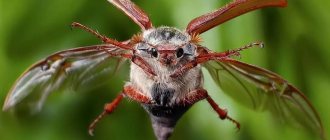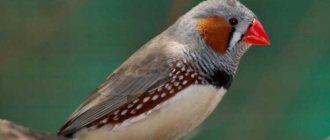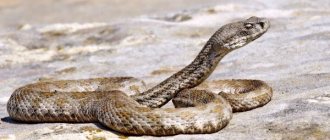Swallows are small birds that belong to the family of swallows in the passerine order. Their difference from other passerine birds is their long wings and tails. The swallow has a wide chest, short neck and flat head. The beak is short, flat, widening towards the base, almost triangular, with a slightly bent end.
The legs are short, weak and with tiny claws. The feathers are short, tightly adjacent to each other, with a characteristic metallic sheen. Female and male individuals differ little in plumage color. On the contrary, chicks in the first days of life are very different in color from adults.
Swallow habitat
Habitat of swallows
Swallows live in almost all regions. For hot countries these are sedentary birds, for the northern regions these are migratory swallows. When frost sets in, the bird flies to warmer regions and returns back in the spring. Usually swallows try to return to their nests from last year. And if these are young birds, then they will certainly begin to build a family nest.
How many types of swallows are there and where do they live?
Types of Swallows
There are 79 species of swallows. A large number of swallows find shelter in people's houses, some settle on rocks and cliffs, and swallows also choose trees to make nests.
Most species have adapted to build strong nests; the outside walls are made of clay lumps soaked in sticky saliva. Some species, with great difficulty, dig holes in the soil of earthen cliffs, make an extension at the end and build a nest there; most nests consist of a large number of feathers folded in a heap. A clutch usually contains 3-5 eggs, which are incubated only by the female.
Martin
Swallows are usually called noble birds, since they are beautifully gifted in a physiological and aesthetic sense. These birds spend the bulk of their lives in flight. They rest in trees, sitting on branches and twigs without leaves, so that they can easily fly in and fly away.
Swallows are songbirds. They are very understanding and smart. Arriving at a new area, they carefully study it. Swallows have learned to distinguish friends from enemies and will only trust those who earn their trust.
Martin
A small and very beautiful bird nests under the roof of a house. This swallow has chosen your house. Since childhood, everyone has been familiar with this bird, which personifies hope, fidelity and rebirth.
Interesting: Birds that cannot fly - list, description, photos and videos
People have a particularly reverent and warm attitude towards the swallow. It’s not for nothing that a good-natured and sympathetic person is called a “swallow.”
Natural enemies
Swallows are birds with excellent flight characteristics, so they are much more likely to avoid dangerous encounters with various predators. Of particular danger to them is the hobby falcon, which is characterized as a fast and agile predator that is capable of attacking swallows in the air.
Important point! Swallows become vulnerable to their enemies during the period of nest construction, when they fly up to bodies of water to find building material.
Where do swallows build their nests?
Swallow's nest
Some species of swallows have become so accustomed to people that they build their nests closer to people. However, birds prefer villages rather than big cities. In rural settlements, swallows predominantly choose small but fairly open formations. Stables, sheds, all kinds of terraces, etc. are suitable for building nests for birds. But their favorite place remains the roof of the house.
Swallow nests can also be found in the wild. Birds settle in the desert or vast steppe. But this happens provided that there are no suitable places for construction nearby. Swallow nests are also found under the ceilings of grottoes, under large tree branches, and even under large nests of feathered predators.
Swallow's nest
Swallows are considered skilled builders. They build nests from lumps of wet soil. Birds find wet soil on the banks of lakes and rivers. City swallows collect dirt in puddles. Having found wet soil, the bird rolls it into a ball with its beak. Wet round lumps are firmly attached to the wall. For gluing, the swallow uses its own saliva.
Blades of grass, thin twigs, horsehair and other similar materials are laid out between the balls. The finished nest is covered inside with down and soft blades of grass. The swallow house shape resembles a deep cup. Both the male and the female are involved in nest construction.
Only after the completion of construction does the romantic period of mating begin. Males tell the female about their love with pleasant chirping. And she, in turn, meekly accepts his proposal. Swallows are considered monogamous birds. A couple is created once and forever.
Reproduction and raising of offspring
Recommended by topic
Zebra Swan Salamander
Swallows are considered monogamous birds, creating pairs once and for all. However, the behavior of some males is polygamous, which is why they can breed offspring with several females.
It often happens that a female, who already has a partner, arrives from the wintering grounds before him and is busy repairing their previous home. After some time, the male also returns from wintering. If at this point the nest turns out to be unfinished, the couple organizes a joint watch, during which one family member searches for building materials, and the other uses available items to eliminate problems with the nest.
After mating, swallows lay up to 5 eggs at a time. The eggs themselves are white and weigh no more than 2 g. Hatching lasts about two weeks, although sometimes this process can be delayed for a longer time due to unfavorable weather. Usually the eggs are incubated by the female, to whom the male brings the caught prey. When the weather in the region is rainy, it becomes more difficult to find food for two, and the female has to look for food on her own while the male replaces her.
Question to the expert
How long do swallows live?
The average lifespan of swallows is about 4-5 years. However, some individuals in the wild are able to live up to 8 years, although this figure is rather an exception.
Caring for chicks
Swallows' offspring are usually born closer to mid-June. The chicks are born very tiny: no more than 2 cm and weighing 1.5 g. They have pale blue skin with a small amount of light fluff. In about a month, sometimes a little earlier, the chicks will get stronger and feel confident enough to fly on their own. So, at the end of July, the chicks are ready to leave the parental nest. However, for some time, usually about a week, parents continue to feed their mature offspring.
The babies are born very weak, which is why swallows sometimes have to break the shell of their eggs so that they can emerge.
After the babies are born, the male and female take turns feeding the offspring, which constantly requires food. Their diet, like that of adult parents, consists mainly of animal protein.
Sexual maturity in older females occurs already in the first year of life. Their first offspring are usually quite small in number, but each subsequent year the number of eggs produced gradually increases. In one season, a female can lay two clutches: one in June, the other in early autumn.
Chicks
Swallow chicks
Birds form their family in early spring. The female incubates an average of five tiny eggs per clutch. The chicks hatch within three weeks. Babies are defenseless and not at all adapted to the environment. That’s why parental care is so important to them. The only activity of the emerging chicks is to open their beaks wide and demand food.
From dawn to dusk, parents hunt various insects. Thanks to caring adults, the chicks grow at an unprecedented rate. Well-fed little swallows take their first flight in less than a month. Despite the fact that the chicks have grown up, the parent swallows continue to feed them. Their diet includes all kinds of bugs, flies and even butterflies.
Nutrition
What do swallows eat? The main diet of swallows consists of crawling and flying insects.
Swallows are so dexterous that in flight they can even grab a large insect, for example, a dragonfly or a grasshopper, but most often the victims are mosquitoes, flies, and midges.
Swallow chicks are characterized by an increased appetite and require feeding about 300 times per day.
Features of swallows
The swallow catches insects.
One feature helps adults feed their offspring well. The fact is that swallows catch insects on the fly. This greatly reduces the time it takes to search for food. Thanks to this property, birds destroy a large number of harmful insects. People appreciate swallows for this, because where there are swallows, there is a good harvest.
Interesting: Why can't most species of migratory birds travel across the ocean?
These nimble birds not only get food for themselves on the fly, but also eat and even sleep. It’s beautiful to watch how swallows rush headlong over a pond, capturing water with their beaks in flight. Swallows spend almost most of their lives soaring in the air. They rarely fall to the ground, since they are almost not adapted to move on the surface.
Despite their tiny size, swallows are very hardy and have great endurance. They are capable of flying great distances. Long flights require unprecedented strength and patience. After all, migration is always fraught with all sorts of dangers and difficulties.
What is the difference between a city swallow and a village swallow?
Anyone who likes to watch swallows fly has probably noticed the difference between them. Indeed, in nature there are several species of these fast-winged birds. Many people know that there are city, village and coastal swallows. They have both differences and similarities.
Swallows: coastal, village, city
The city swallow, also known as the swallow, has a slightly shorter tail than its relative. A distinctive feature of this genus is its blue-black back and white breast. Barn swallows have a long forked tail. The forehead and throat are full of reddish plumage. They look quite larger than the city ones. They like to affectionately call the village bird a killer whale. The killer whale also differs from the funnel by the sharp tips of its wings and a fairly wide beak. Pointed wings allow killer whales to demonstrate masterly flight.
How to distinguish male from female swallows
Males and females are very similar. They can only be distinguished by their plumage: in females the color is not so pronounced. Also, females have a shorter tail than males. Chicks and adults are identical in plumage.
By the way, swallows create pairs once and for life.
Signs associated with swallows
For example, if swallows arrived in early spring, it means there will be a good grain harvest in the fall, but if they arrive late, you may not expect a generous harvest. Before the rain, these birds begin to fly low above the surface of the earth. And before a clear and warm day, you can hear their cheerful and sonorous chirping.
Swallow before the rain
A flock of swallows has always been considered a very auspicious sign. If you notice a flock rushing overhead, it means good luck to you. If swallows scurry around your house, expect good luck. And if a flock flies over the lovers, then great mutual love awaits the couple.
Swallows' vision
Swallow
The swallow has very good eyesight. She perfectly sees a tiny insect in flight at a distance and pursues it, orienting herself only with her eyes. The barn swallow sets up a nest in a building so that it is covered from above with a roof. It happens that large companies settle in such places. The nest looks like a quarter of an empty ball. On average, it takes one pair eight days to build a nest. Stems, hair, feathers and other soft materials are spread inside the nest. A swallow's nest can last for several years and for subsequent generations.
Interesting: The most unusual birds in the world - list, description, photos and videos
general description
Swallows belong to the passerine family, but, unlike most of their fellows, they spend almost their entire lives in the air. This is even reflected in the name, because “lasta” literally means “to fly” from ancient Slavic.
Appearance of a swallow
The swallow is a miniature bird with a body length of up to 22-23 cm and a weight of about 20 g. At the same time, it has impressive wings - up to 30 cm in span. Thanks to this and due to the elongated shape of the body, the swallow develops high speed, maneuvers excellently and does not get tired even during long flights.
Swallows have a large mouth, but a small beak to make it easy to grab small insects. She has very thick and dense plumage, which fits tightly to the body and does not interfere with flight speed. The grippy claws help you sit comfortably even on wires. Unlike swifts, swallows can land on the ground, but they do so infrequently.
Photo: vladimirkrym.livejournal.com
Male and female swallows: differences
In swallows, there are almost no differences between males and females. The only difference is that the tail of the females is a little shorter and the plumage is paler - this can sometimes be noticed when the birds are nearby.
Photo: zen.yandex.ru
Singing
Swallows are very social, so they communicate a lot with each other. Their chirping ends with expressive trills. They also have a good memory, so they are able to distinguish each other’s voices.
Photo: ao111444.blogspot.com
Harbingers of rain
There is another sign: if swallows fly low, it will rain. This pattern actually has a logical basis. When humidity rises, birds are forced to descend lower to hunt insects. But the same phenomenon can be observed on warm evenings, especially near bodies of water.
Photo: placepic.ru
How long do swallows live?
Swallows do not have the longest life expectancy. For example, barn swallows, common in Russia, live in the wild for about 4 years. Maturity comes in the second season.
Photo: sibirds.ru
Barn Swallow
The barn swallow's
upper body and crop are dark blue, with a metallic tint. The throat and forehead are bright chestnut. The bottom is light yellowish in color. Females are distinguished by paler shades from males. Barn swallows are found throughout Europe, western and central Asia.
This species of swallow has been accustomed to man and his home since ancient times. Her attachment to a human home led to our love for her, and in the northern countries people were taught to consider the arrival of a swallow as the beginning of spring, and the departure as the beginning of dull autumn.
City swallow
City Swallow
The entire body of the city swallow is covered with blue-black feathers, only the tail is white below. The eyes are brown, the beak is almost black. The chicks have black plumage. The city swallow is found almost in the same place as the village swallow and also a little to the north. This species of swallow builds nests only on buildings, with protection from the rain on top. The shape of the nest resembles that of a barn swallow. Nest construction lasts 10-15 days.
Beregovushka
Shore Swallow and Nest
The feathers on top are earthy-brown in color; below - white with a brown-ash stripe on the chest. The shorebird is common in most areas; it settles mainly on steep banks. With great effort, they dig deep holes for nests in the dense earth, most often along the top of a slope, so that water does not flood them.
Thread-tailed Swallow
Thread-tailed Swallow
The wings are narrow and long, the tail is long and fork-shaped. The beak is short and triangular in shape. The legs are short and weak, but with tenacious claws. Thanks to which swallows cling to walls and steep cliffs. The top of the body is dark, with a blue tint, and the bottom is light.
Swallows are monogamous birds; partners remain faithful to each other for one season. In the northern regions, swallows make one clutch per year, in the southern regions - 2 clutches.
Swallows are quite stable and can withstand various loads well. These birds bring great benefits to humans by exterminating small insects that other birds do not eat - mosquitoes and flies.
Lifestyle
Swallows spend their entire lives in constant motion and hardly ever rest. Their strong and developed wings help them not get tired in flight. The speed can reach 150-160 km/h. But on the ground the bird moves heavily and awkwardly due to its weak legs.
Swallow habitats
Basically, swallows live in warm countries, but sometimes they also settle in our latitudes. In Europe and Asia, coastal and rural species are especially common, but urban ones are also increasingly common. A large flock flies all day, and when it loses its members, it finds them by their voices.
Photo: sibirds.ru
Diet
The main part of the swallows' diet consists of small flying insects, which they catch in flight. This is why birds from regions with cold winters are forced to fly away in search of food.
Photo: maks-star.ru
Wintering
Swallows in northern countries are migratory birds, and they fly away in the first rows. Large flocks travel to Africa, Latin America and Saudi Arabia. Barn swallows also choose Indonesia.
Photo: jtapi-public-2.appspot.com
Captivity
Due to the fact that swallows often settle near humans, questions periodically arise about keeping the bird in captivity. This is especially true for found chicks. They can indeed be safely fed and even accustomed to a room or enclosure, where they will then return to spend the night. But you shouldn’t keep a swallow in a cage.
Photo: clasbio.ru
Waxwing (60 photos): description of the bird, where it lives and what it eats











